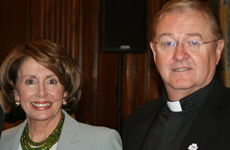Description of Yes result as an end to Catholic Ireland greatly exaggerates
Posted By: August 26, 2018
Voters were almost all educated in church-run schools
Patsy McGarry. Irish Times. Dublin. Tuesday, May 29, 2018
That collective moan you may have heard reverberating across Ireland on Monday morning was from Ireland’s Catholic bishops. It was not delayed reaction to the results of last Friday’s referendum. Instead, they were listening to RTÉ Radio 1’s Today with Sean O’Rourke, and it had been announced that Bishop of Elphin Kevin Doran was a guest.
All their anxieties came flocking home when he said to Catholics listening “if you voted Yes knowing and intending that abortion would be the outcome then you should consider coming to Confession.” Just what the bishops needed after Friday.
Bishop Doran has a record of doing this sort of thing to his brother bishops. During the same-sex referendum campaign in 2015, he said in a Newstalk interview that “people who have children are not necessarily parents.” Gay parents were not necessarily parents because “the whole relationship between life-giving and parenthood” has been separated, he said.
A press conference was called hastily in Maynooth where Catholic primate Archbishop Eamon Martin and Archbishop of Dublin Diarmuid Martin attempted to defuse the situation.
The latter Archbishop Martin refused to say whether Bishop Doran retained his confidence and described “the parent’s comment” as “an unfortunate phrase.” Six days later Bishop Doran expressed regret.
In August 2013, speaking as a member of the board of governors at Dublin’s Mater hospital, then Fr Doran said the hospital “ could not comply” with the Protection of Life During Pregnancy Act, just then passed. A month later the Mater’s board said: “the hospital will comply with the law as provided for in the Act”. Fr Doran resigned from the board.
Much more typical of how most Catholic bishops see their church after the referendum would be the view of Bishop of Killaloe Fintan Monahan. He told Raidió na Gaeltachta yesterday: “it’s a church and there are plenty of people with different attitudes within it and we have to accept that.”
Out of kilter
As out of kilter have been observations that Friday’s referendum represented an end to Catholic Ireland. More accurately, what it illustrated was an end to a particular model of clerically dominated Catholic Church in Ireland.
It also showed the degree to which the authority of Ireland’s Catholic bishops has been eroded. The bishops know this. It was why, during the referendum campaign, they confined themselves to a staggered release of individual statements over weekends leading to the vote.
According to the RTÉ exit poll, almost a third of practicing Catholics voted Yes last Friday. As Archbishop Diarmuid Martin recalled on Sunday “one parish priest said to me he talked to two elderly ladies who go to Mass every day and he said to them ‘what way are ye going to vote?’ and they said they were ‘going to vote Yes. The church always told us what to do, and now it’s time for us’.”
The authority of Catholic bishops does not now even extend to some elderly ladies in Ireland.
Archbishop Martin said the referendum result also showed “the city/rural divide doesn’t exist. There’s one culture in Ireland.” It is a culture which grew in a state where 93 percent of primary schools are controlled by the Catholic Church and where, according to The Irish Times exit poll last Friday, a great majority in every age cohort from 18 to 64 were Yes voters.
This prompted Archbishop Martin to ask “is our system of working with young people working? Are our schools delivering for the investment we make in faith development?” To which the answers seem clear: no, and no.
Meanwhile, six men began training for the Catholic priesthood in Maynooth last autumn, the lowest number since its foundation in 1795. According to the Association of Catholic Priests (ACP) figures the number of priests in active ministry in Ireland has dropped by 43 percent since 1995.
ACP co-founder Fr Brendan Hoban has said that, according to studies, “Ireland’s priests will have almost disappeared in 20 years.”
None of which means Catholicism is finished in Ireland.
Witnessing
What we are witnessing is the disappearance of what might be described as “the church that Paul built,” a reference to Cardinal Paul Cullen. Archbishop of Dublin from 1852, he “Romanized” the church, centralized its structures, and introduced processions and devotions from Europe.
He laid the foundations for an Irish Catholic Church which became a powerful alternative institution in the late 19th century so that by independence in 1922 it was more powerful than the new state itself, particularly in education and healthcare. It dominated Ireland through most of the 20th century.
But that model of church was not at all typical of the long history of Christianity in Ireland or even of post-Reformation Irish Catholicism. The Reformation began 500 years ago and its initial 300 years saw Irish Catholics suffer greatly under a regime of penal laws.
These were described by 18th-century Anglo Irish MP Edmund Burke as “a machine of wise and elaborate contrivance, as well fitted for the oppression, impoverishment, and degradation of a people, and the debasement in them of human nature itself, as ever proceeded from the perverted ingenuity of man.”
But Catholicism survived in Ireland. That pattern continues.
Despite growing secularisation, four statutory reports into clerical child sexual abuse (Ferns 2005, Ryan 2009, Murphy 2009, Cloyne 2011), an interdepartmental report on the Magdalene laundries (February 2013), the census of April 2016 showed that 78.3 percent of Irish people still identified as Catholic.
They may not be “good Catholics” in the mid-20th-century sense, but in terms of practice, they are not very different from their pre-Famine ancestors.










